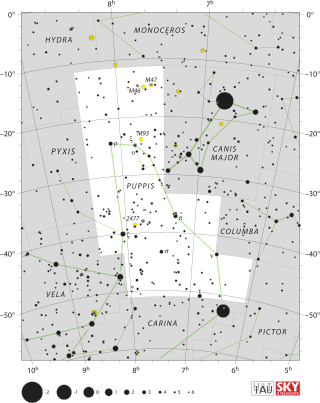Pi Puppis
Second-brightest star in the constellation of Puppis From Wikipedia, the free encyclopedia
Pi Puppis, Latinized from π Puppis, also named Ahadi,[11][12] is the second-brightest star in the southern constellation of Puppis. It has an apparent visual magnitude of 2.733, so it can be viewed with the naked eye at night. Parallax measurements yield an estimated distance of roughly 810 light-years (250 parsecs) from the Earth. This is a double star with a magnitude 6.86 companion at an angular separation of 0.72 arcsecond and a position angle of 148° from the brighter primary.[13]

| Observation data Epoch J2000 Equinox J2000 | |
|---|---|
| Constellation | Puppis |
| Right ascension | 07h 17m 08.55678s[1] |
| Declination | −37° 05′ 50.8962″[1] |
| Apparent magnitude (V) | 2.733[2] |
| Characteristics | |
| Spectral type | K3 Ib[3] |
| U−B color index | +1.238[2] |
| B−V color index | +1.608[2] |
| Variable type | SRd[4] |
| Astrometry | |
| Radial velocity (Rv) | +15.8[5] km/s |
| Proper motion (μ) | RA: −10.05[1] mas/yr Dec.: +6.47[1] mas/yr |
| Parallax (π) | 4.04±0.33 mas[1] |
| Distance | 810 ± 70 ly (250 ± 20 pc) |
| Absolute magnitude (MV) | −4.5[6] |
| Details | |
| Mass | 11.7±0.2[7] M☉ |
| Radius | 235[8] R☉ |
| Luminosity | 11,378[8] L☉ |
| Surface gravity (log g) | 0.13[8] cgs |
| Temperature | 3,990–4,055[9] K |
| Age | 20.0±3.9[7] Myr |
| Other designations | |
| π Pup, CPD−36°1211, FK5 278, GC 9706, HD 56855, HIP 35264, HR 2773, SAO 197795, PPM 283747, CCDM J07171-3706A, WDS J07171-3706A[10] | |
| Database references | |
| SIMBAD | data |
The spectrum of Pi Puppis matches a stellar classification of K3 Ib.[3] The Ib luminosity class indicates this a lower luminosity supergiant star that has consumed the hydrogen fuel at its core, evolved away from the main sequence, and expanded to about 235 times the Sun's radius. The effective temperature of the star's outer envelope is approximately 4,000 K,[9] which gives it the orange hue of a K-type star.[16] With a mass 11.7[7] times that of the Sun, this is a short-lived star with an estimated age of 20 million years.[7]
It is a semiregular variable star[4] that varies in apparent magnitude from a high of 2.70 down to 2.85.[17] Pi Puppis is the brightest star in the open cluster Collinder 135.[18]
Naming
The star has the traditional name Ahadi, which is derived from Arabic for "having much promise".[11] In Chinese, 弧矢 (Hú Shǐ), meaning Bow and Arrow,[19] refers to an asterism consisting of π Puppis, δ Canis Majoris, η Canis Majoris, HD 63032, HD 65456, ο Puppis, k Puppis, ε Canis Majoris and κ Canis Majoris. Consequently, π Puppis itself is known as 弧矢九 (Hú Shǐ jiǔ, English: the Ninth Star of Bow and Arrow.)[20]
References
External links
Wikiwand - on
Seamless Wikipedia browsing. On steroids.

